I am often asked by homeowners planning interior painting for their home, if it is correct to paint the trim in a particular room a different color than the trim in the rest of their home. Many times the issue arises when they are planning a particular color, on account of a color they have seen in a magazine or while visiting a friends home. Maybe they’re trying to match colors in a particular fabric they are planning to use in that room. Anyway, the problem arises with what to do with the trim for that room. How do you work it into the existing color scheme of your home?
While there is no absolute rule about trim color, that if broken, would cause you to be arrested by the color scheme patrol, there are some things you should consider.
1. The trim and ceilings of your home are what establishes a unified look and feel throughout your home. You can change your walls to any color that you like, or that fits with the theme you have planned for the interior of your home. The use of one color on the trim and ceilings will give you a smooth transition between wall colors as you travel throughout your home. Without this consistency, your home takes on a feeling of disunity.
2. White trim and some off-white colors will go with any wall color. That is why it is so popular. It gives you much greater flexibility in interior color coordination and design. Deciding to paint your trim a color other than white will limit your decorating options; however, I have seen some marvelous color co ordinations while using more color for trim.
If you really want to change the color of the trim for a particular room, then test the color. Try to get a feel for how it will impact the rooms or halls adjacent to that room. Will it be completely separated by a door? Will the door be closed most of the time? If the room is open to other areas of the house that are easily seen, how will that impact the color theme for the other parts of your home?
You don’t want to put a lot of time and effort into painting a room if in the long run you’re not happy with how it makes the rest of your home look. Test the color on a door jamb or baseboard and then stand back and get a feel for what it does for unity of passage from other rooms to that room. It would be a good idea to wait a few days to see if you grow tired of the transition between colors. Often what we initially think looks good, loses its appeal over time.
Nicky Taylor CEO of Painters Flair And Our Painter Services





